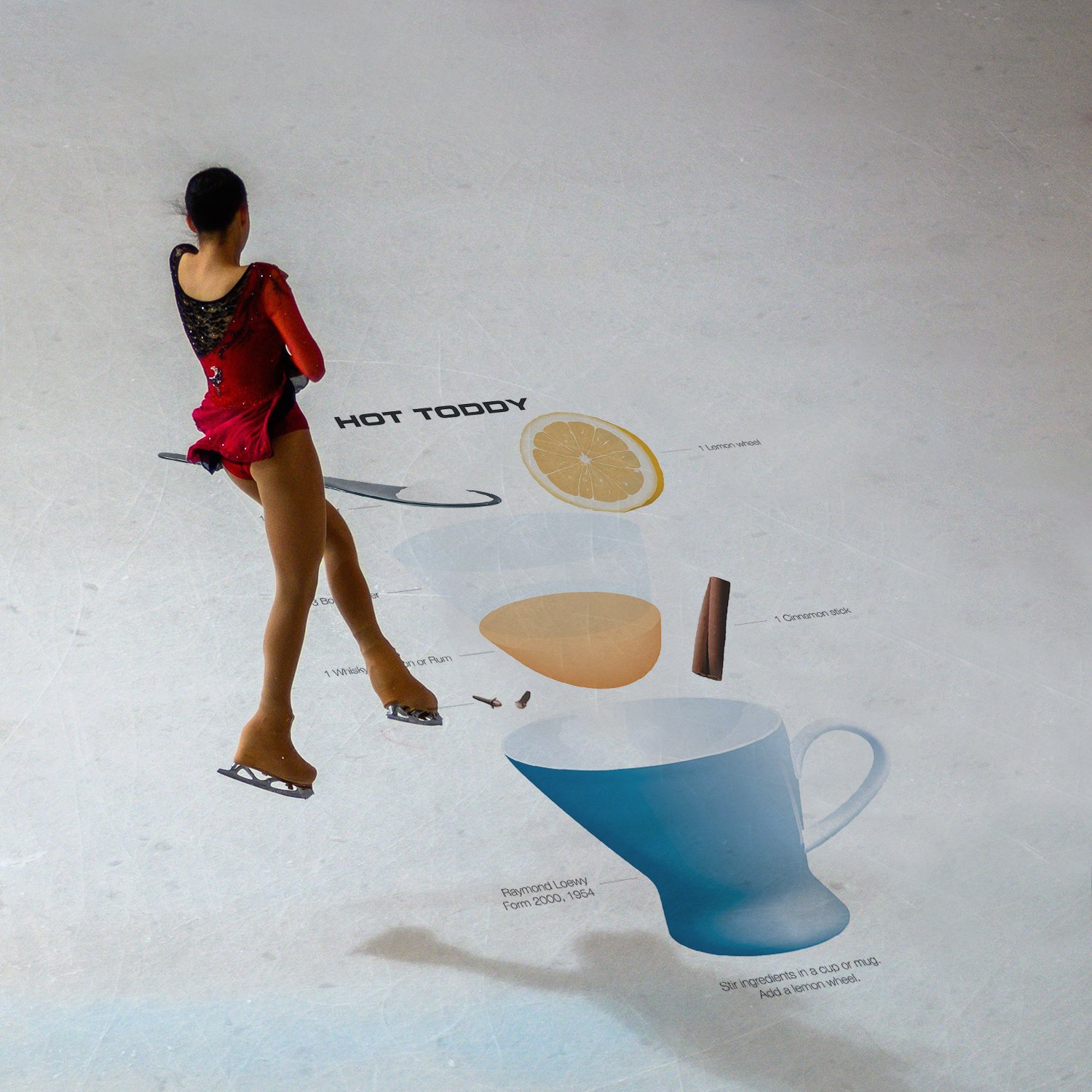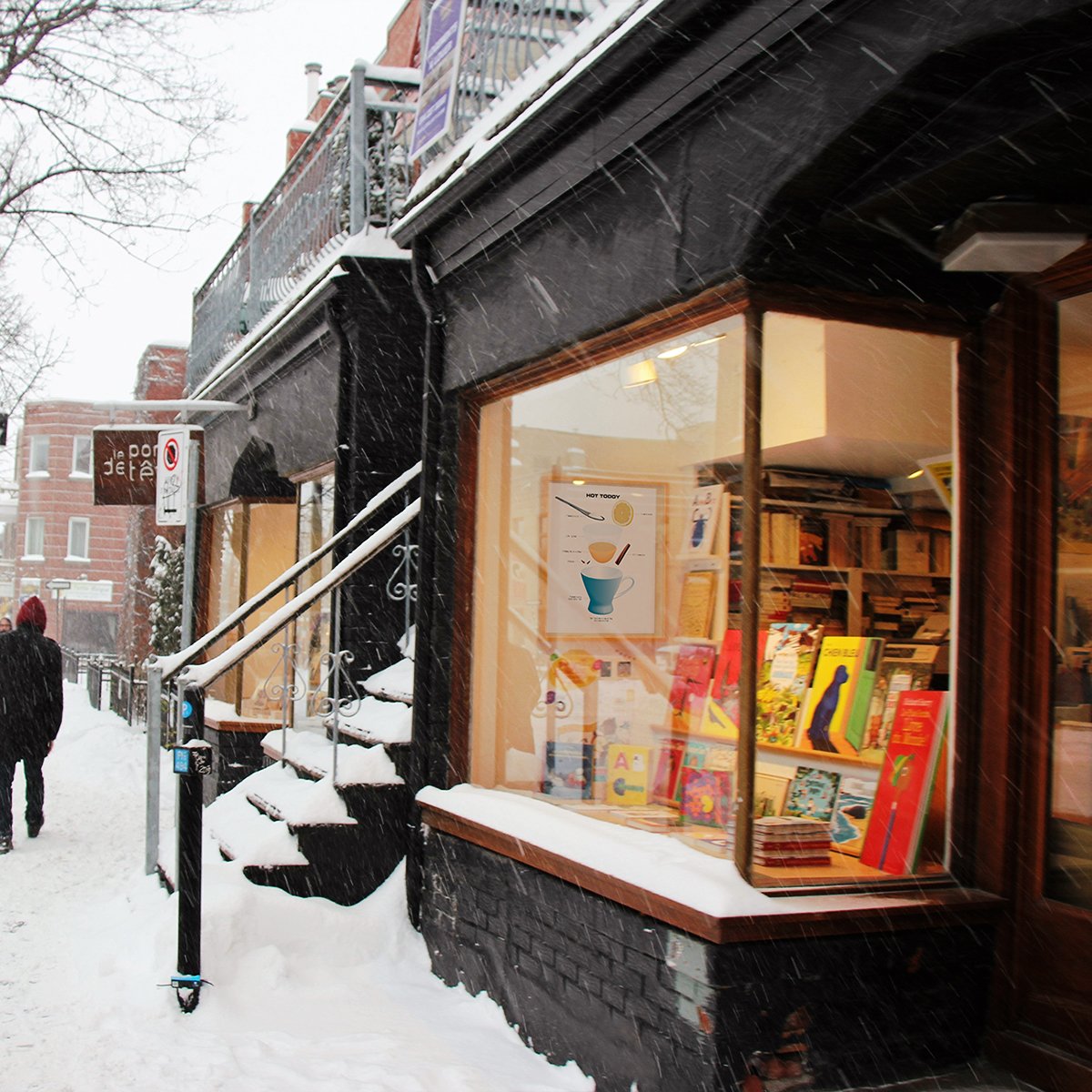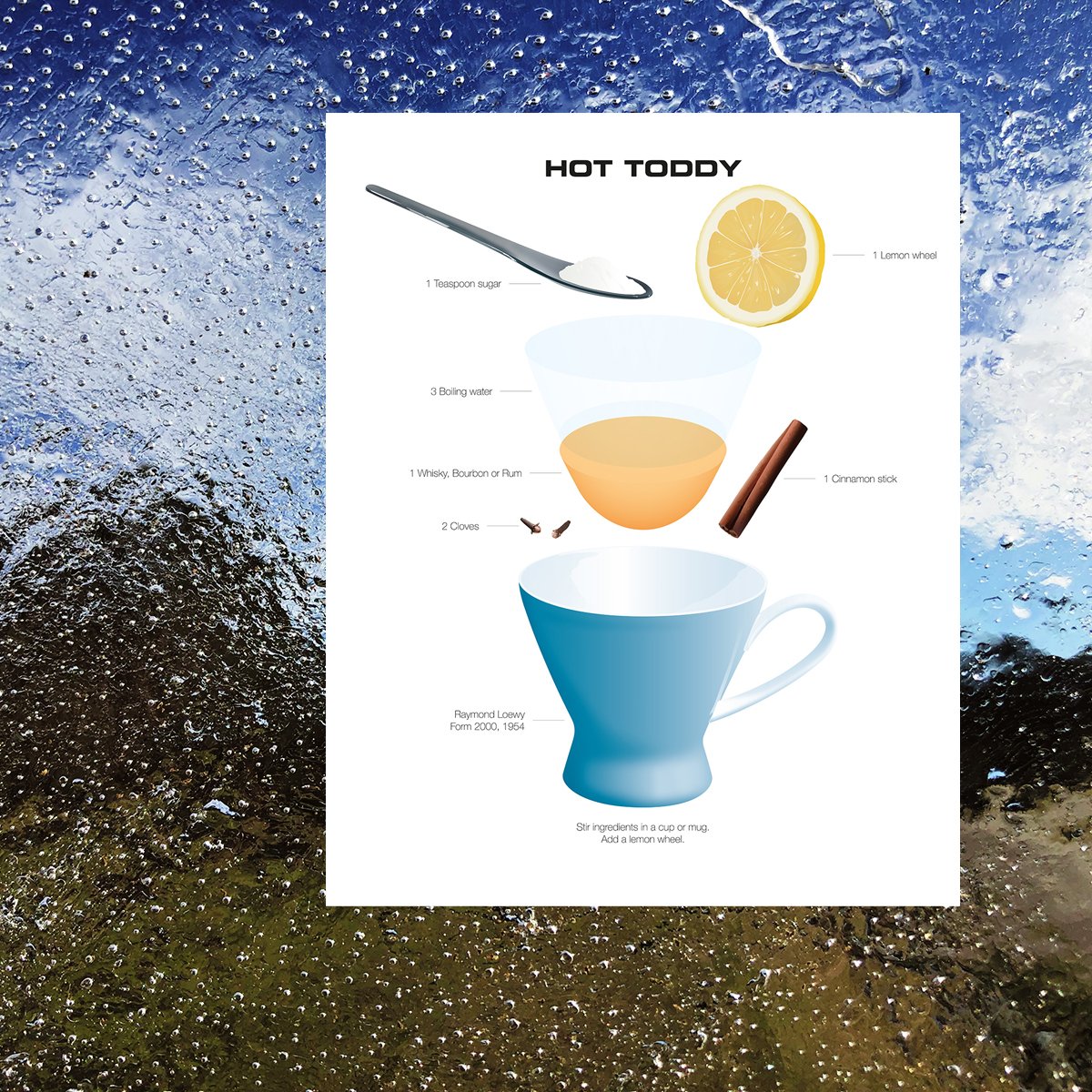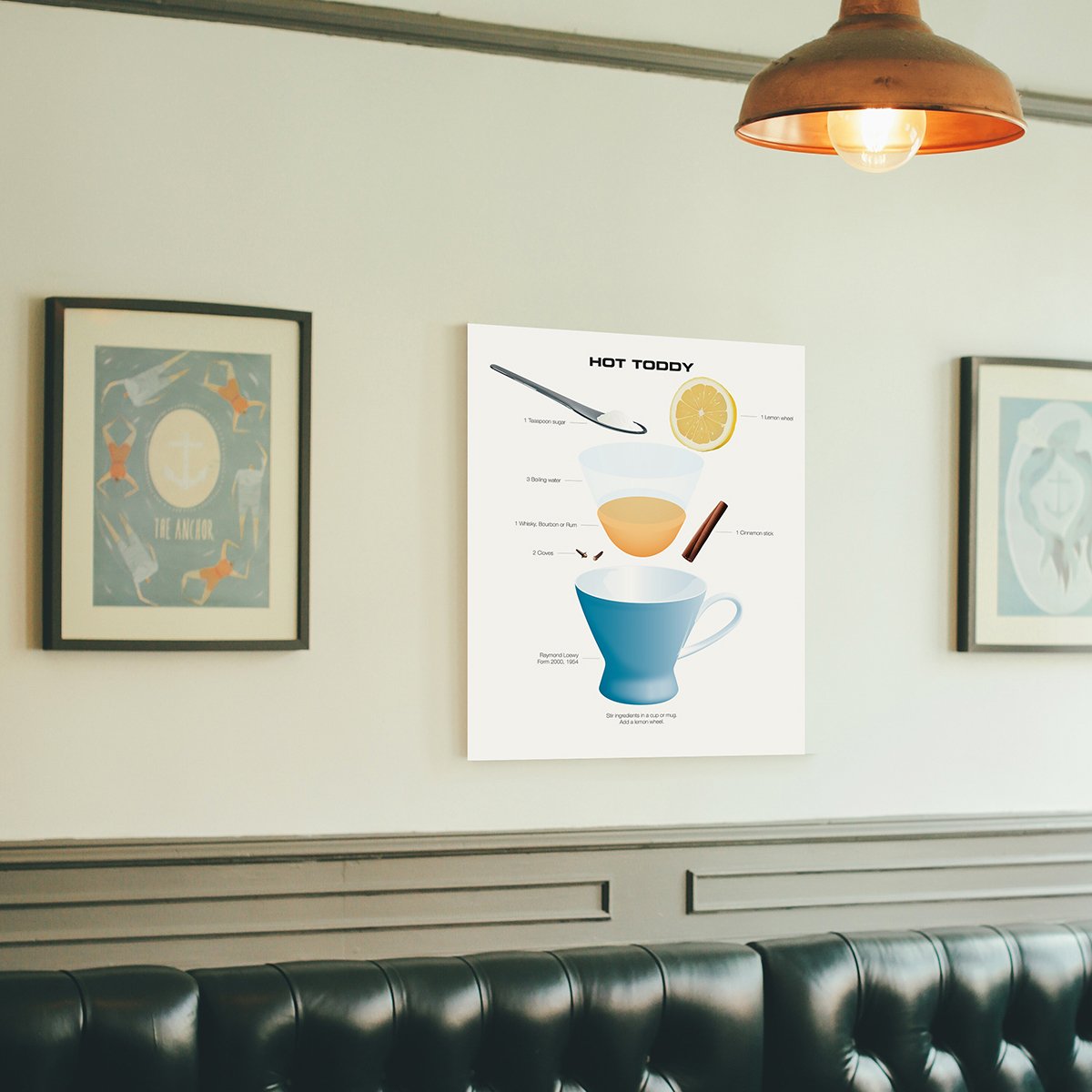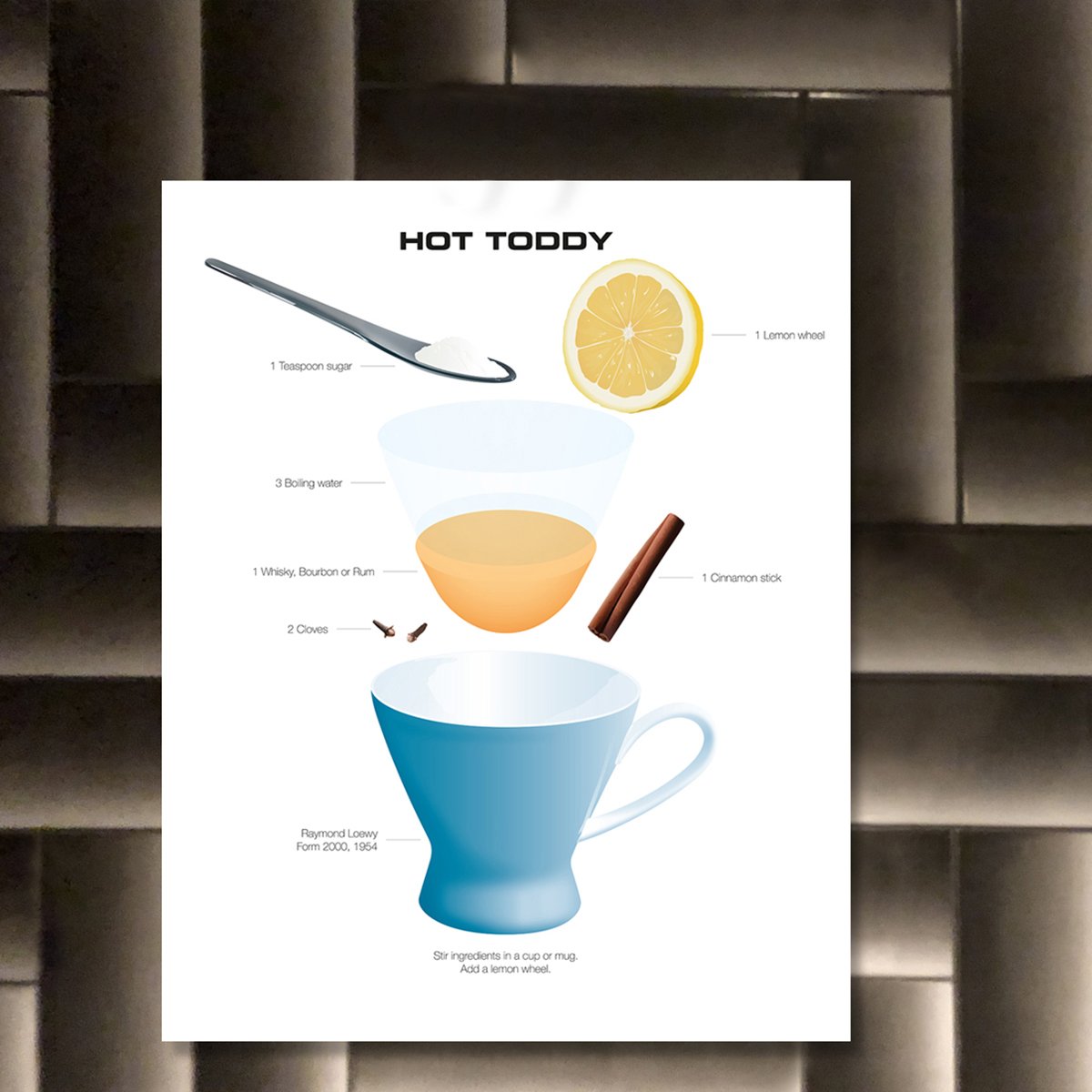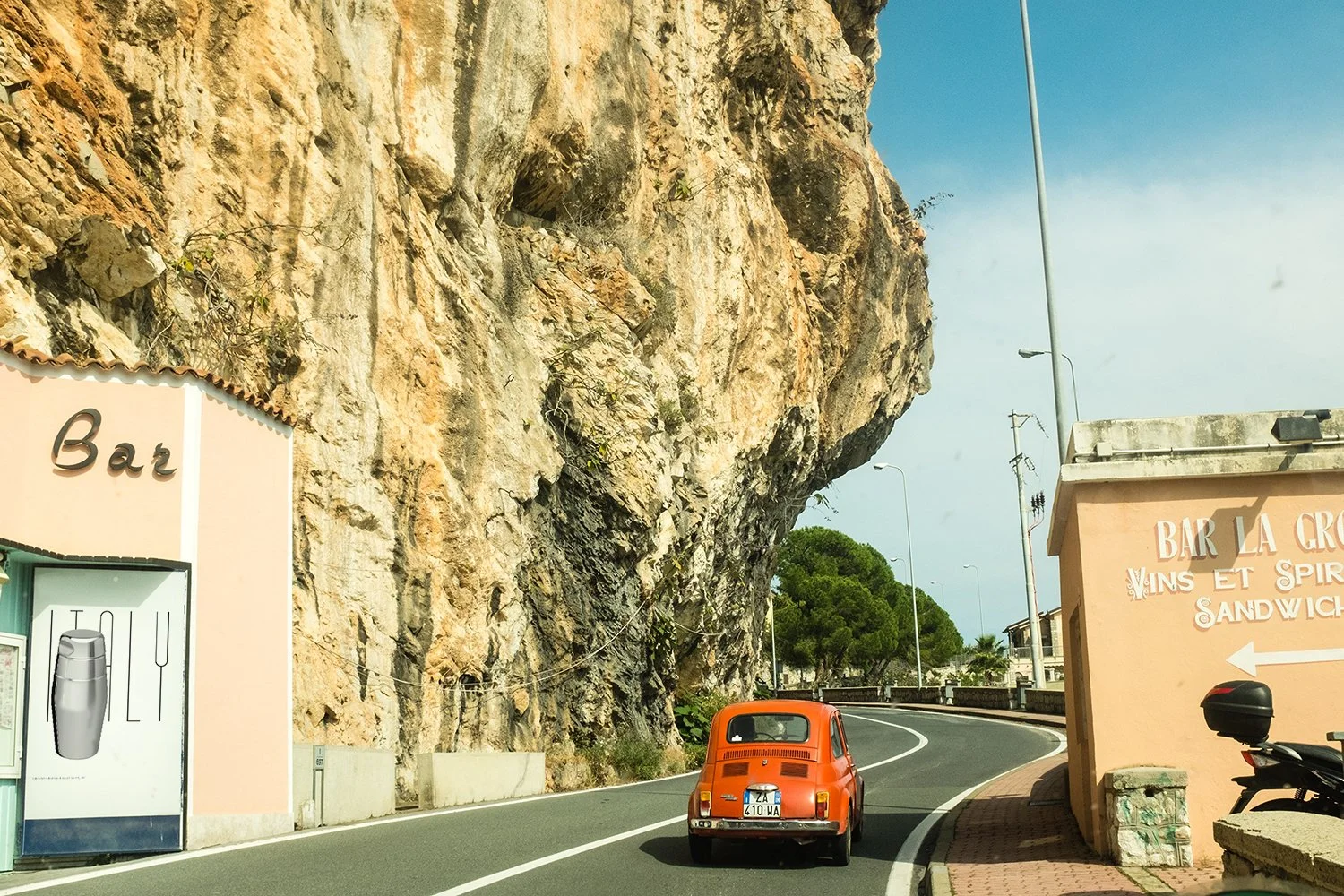The history of the Toddy dates all the way back to British-controlled India in the early 17th century. The Hindi word “taddy” meant “beverage made from fermented taddy palm sap” a drink that was served cold. By 1786 the British had changed the official meaning of taddy and defined it as “a beverage made of alcoholic liquor with hot water, sugar, and spices.” The British claimed it as their own and started serving it in pubs during the winter months using Scotch whisky, hot water and exotic spices from India.
At the time of the American revolutionary war in 1775 the Hot Toddy had reached North America. The soldiers exchanged the Scotch to rum and brandy and drank it before battle as a “liquid courage.”
Another story tells of a 19th-century Irish physician, a Dr. Robert Bentley Todd who used to prescribe his patients a mix of brandy, cinnamon, sugar and hot water, making it a Toddy. An article in a Vermont newspaper from 1837 about “How to Take Cold” made the Hot Toddy out to be a cure-all. The trick, the article stated, if your child begins to snuffle, has a fever and you don’t want to call on a doctor, is to first feed it excessive amounts and then give it a Hot Toddy. These recommendations have changed a bit since.
Dubbed by the press as “The Man Who Shaped America” Raymond Loewy was an American industrial designer born in Paris, France in 1893. Loewy moved to New York in 1919 where he first worked as an illustrator for Vogue and Harper’s Bazaar. During his career he made everything from streamlined locomotives, buses, cars, interiors for the Concorde and for the Apollo space mission to logos for Exxon, Shell, TWA, BP. He designed the cup, Form 2000, in 1954 for Rosenthal.
Celebrate the Hot Toddy Day with this magnificently warming drink made with your favorite barrel aged spirit. Be it rum, whisky, bourbon, brandy or cognac.
Bloody Mary Day, January 1
After a long night of New Years Eve parties, January first was the natural candidate for becoming Bloody Mary Day even though a Tomato Juice Cocktail or a Virgin Mary might be better for recuperating.
The predecessor to the Bloody Mary drink was the Oyster Cocktail, a drink that reportedly came to London from the Manhattan Club in New York in 1892. The drink closely resembles a modern day Bloody Mary save for the fact that it was non-alcoholic, was served warm and contained seven small oysters. It quickly evolved into the still alcohol free Tomato Juice Cocktail that was extremely popular as a health tonic during the 1920s. The Bloody Mary is often attributed to a bartender named Fernand “Pete” Petiot, who is said to have created his first version in the early 1920s at Harry’s American Bar in Paris. After Prohibition, Petiot moved to New York where he presided over the King Cole Bar at the St. Regis Hotel. Here he enhanced the drink with horseradish, Tabasco, lemon juice and celery salt creating the drink we know today. But as with most classic drinks there are several origin stories.
The Vaudeville performer and Hollywood actor George Jessel claimed he created the Bloody Mary in 1927. After a heavy night of drinking in Palm Beach he and a friend were still at it at 8 am. Having a volleyball date with a Vanderbilt at 9.30 he asked the bartender for a hang over and sobering up cure. The bartender reached for a bottle gathering dust at the bottom shelf, a bottle of vodka. Thinking it smelled like rotten potatoes he asked for Worchestershire Sauce, tomato juice and lemon to cover it up. Feeling better he realized he had created a new drink. A friend called Mary came into the bar still wearing her white evening gown. Trying the drink she spilled it over her dress and exclaimed “Now you can call me Bloody Mary.”
For this special occasion I made a riff on the classic Bloody Mary, making it into a cocktail. Blend 6 cocktail tomatos (instead of tomato juice) together with the rest of the ingredients. Pour into a shaker and shake until ice cold. Double strain into a cocktail glass. Decorate with a cocktail tomato on a cocktail skewer.
Happy New Year of Cocktails
A brand New Year is here starting the Year of Cocktails. The gaol is to make all of the 52 cocktails that are presented in our almost brand new cocktail book. Starting with the Bloody Mary Day on January first and all the way until the end of 2024 with the last cocktail on the list being the true classic, the Champagne Cocktail.
We all hope 2024 is going to be an amazing year, specifically an amazing year of cocktails.
The Perfect Gift That You Don't Choose Yourself
Sometimes gift giving is hard. What do you give to a relative you don’t even know that well, or a co-worker, or in some cases even your close family. The perfect solution could very well be a gift card. The only downside is that they are usually only valid for a year. This is not, however, the case at mobilità, we will let you use it for at least 3 years (and if you ask kindly we can prolong it even further).
So take the opportunity to get the easiest but yet the most loving gift we can think of. A gift card at mobilita.se/shop. The shop grows almost every week with new prints, totes, throw pillows and t-shirts and last, but not least, our brand new cocktail book A Year of Cocktails. So wait no longer, Christmas is right around the corner.
The Italian Saint and Her Swedish Cat Shaped Bun Companion
Today on December 13 Swedes all over the world celebrate the Italian Saint Lucia of Syracuse, also known as Saint Lucy, with boys and girls wearing white dresses, holding candles and singing special Lucia songs. It wouldn’t be a proper Swedish celebration without fika so Lucia comes with a special treat, a traditional Swedish pastry called Lussekatt. This is a sweet bun filled with saffron and raisins that has been baked and enjoyed in Sweden during this season since the 17th century, even though the saffron wasn’t added until the late 1800s. It was probably first introduced by German and Dutch merchants in the 1600s, who brought a sweet Christmas bread they called duivekater to Gothenburg. Duivekater turned into the more Swedish Dövelskatter (katt is cat in Swedish) and when it started getting associated with Lucia celebrations the name changed to Lussekatt. Today this not very cat shaped bun is so popular, every December 13 Swedes eat an estimated 8 million of them, almost one for each Swede.
Santa Sees You!
Finally it’s December and at least in Stockholm we’ve got snow. Feeling the Holiday spirit we just released some new Christmasy coasters on Red Bubble. Something to think about to maximize the amount of presents from the man with the bag and to minimize the risk of getting a lump of coal instead. You can find them at our Made Close page on Red Bubble along with a whole range of Holiday themed products.
https://www.redbubble.com/people/MadeClose/explore?asc=u&page=1&sortOrder=recent
Have a lovely weekend.
Black Friday Book Release
As you all know, today is Thanksgiving (Happy Thanksgiving All) and tomorrow is Black Friday. We don’t usually celebrate Black Friday at mobilità but when it coincides with our book release we just couldn’t help ourselves. We celebrate by offering A Year of Cocktails for 850 SEK from now until midnight on Sunday the 26th. After that the book will be 1,100 SEK so take the chance of saving 250 SEK (almost $24).
Again, Happy Thanksgiving!
A Proof of A Year of Cocktails
Celebrating getting the proof of my first cocktail book (and actually my first ever book of any kind) in the best possible way, with one of the cocktails featured in the book, a Moonwalk (and a Roy Rogers). This drink, made with Grand Marnier, grapefruit juice, champagne and rose water, was made to celebrate the Apollo 11 moon landing on July 20, 1969. Not to in any way compare the feat of the moon landing with the release of a book but it is nevertheless something to celebrate and what better way to celebrate than with a cocktail created for a celebration.
The Spookiest Drinks for the Spookiest Week
When Halloween is on a Tuesday, Día de los Muertos is on a Thursday and Swedish All Saints Day is on Saturday there are a lot of days in need of a special cocktail. There are thankfully several cocktails that fits into that spooky category like Bloody Mary, Zombie, Blood and Sand, Death in the Afternoon, El Diablo and last but not least the Last Word.
Happy Fashion Halloween!
The fashion Halloween of 2023 featuring Karl Lagerfeld.
After having gone through the better part of the Rat Pack with Dean Martin, Sammy Davis Jr. and Frank Sinatra from 2018-2020 and Elvis Presley in 2021 we ventured into the movie with a James Bond themed pumpkin in 2022. This year we headed towards the world of fashion with Karl Lagerfeld, one of the true giants.
Happy Halloween!
Negroni Week is Discount Week
This week is Negroni Week and if you haven’t started already it’s time to stir one up. Preferably using the Alessi Shaker 870 designed by Carlo Mazzeri and Luigi Massoni in 1957. Or buy the Random Things poster with the shaker, why not together with a Negroni poster. If you’d like you can use the discount code NEGRONI for either of the two posters to get 10% off but no pressure, you can buy them without the code as well. Being Negroni Week the code should apply to the Negroni Sbagliato poster as well, and it does.
A Whole Year of Cocktails
Almost since the start of the cocktail print project I have been asked when I will make it into a book and finally I’ve got an answer. It is happening now. I decided to make it into two separate books with 52 cocktails in each. One cocktail per week for a whole year. Or if you’d like to go about it another way, all of them are also attached to a date or at least a part of the year. Like the Blood and Sand for International Scotch Whisky Day (yes there is such a day, February 8) or a Zombie to celebrate tiki pioneer Donn Beach’s (a.k.a. Don the Beachcomber) birthday. Or why not make a Saketini, a cocktail created for the 1964 New York World’s Fair, on the date the fair opened their gates, April 22.
The book comes complete with the history of the cocktail, the story about the glass designer and the history of the date that the cocktail is in some way attached to.
More information is to come but expect it to be ready in time to make a fabulous gift for the holiday season.
But first thing first. Here is a teaser. Enjoy!
The Shaker That Conquered the World
The Alessi company was founded in 1921 by sheet metal worker Giovanni Alessi Anghini who set up shop in Omegna, not far from Milan. The company started out making tableware in copper and brass but they soon expanded to coffee pots, trays and other household products. In 1938 Alessi introduced stainless steel and after the war this entirely replaced brass in the production. From the 1930s until the ’50s Carlo Alessi, the son of Giovanni, was head designer but when his younger brother Ettore joined the business in 1945 he made Carlo realize the potential in hiring external designers. One of the first project being designed outside the family was the incredibly successful Shaker 870, created by Carlo Mazzeri and Luigi Massoni in 1957.
Carlo Mazzeri was born in Oleggio, Italy in 1927 and studied architecture in Venice. Just a year after graduating in 1956 he designed the shaker for Alessi with Luigi Massoni. During the 1960s and ’70s he kept working for Alessi alongside Anselmo Vitale, designing a series of products for the hotel industry. Working with industrial construction, Mazzeri also made the new Alessi plant in Omegna in the 1960-1971.
Luigi Massoni was born in Milan in 1930 and this is where he studied at the “Collettivo di Architettura”. One of his first major designs was the Shaker 870 but he continued working with Alessi, creating the Serie 5 containers. Massoni wasn’t just working as an architect and designer, he was also a freelance journalist and in 1959 he founded “Mobilia” a center for the promotion of Italian design. Through the years Massoni kept designing for the home and kitchen working with Boffi and Guzzini.
Through the years Alessi has worked with designers like Achille Castiglioni, Patricia Urquiola, Zaha Hadid, Jasper Morrison and Philippe Starck.
A Designer of Everything
When the SAS Royal Hotel in the Danish capital was finished in 1960, it was a marvel. It was Copenhagen’s first skyscraper and it is considered to be Arne Jacobsen’s principal work of architecture. The building was designed with two separate sections with different functions. The 22 story tower contains 275 hotel rooms and the lower horizontal building held the hotel foyer, a restaurant and a conservatory. Regardless of the fact that the building was situated in the center of Copenhagen, 14 kilometers from the airport, it was also an airport terminal. Here SAS passengers could check in their luggage and wait in the stylishly furnished lounge for the SAS airport shuttle to whisk them away to their flights.
In the end, the most remarkable result of the project wasn’t the building itself but rather the furniture that Arne Jacobsen designed for the hotel. Not only did he create the Egg, he also designed the Swan chair and the Drop chair as well as a wide range of other custom furniture, glass wear, textiles, cutlery and more, specifically for the hotel. Just like Gio Ponti in Italy, Arne Jacobsen preferred to design all aspects of a project himself. From the structure to the furniture and down to details like door handles.
In keeping with the design trends of the day, Arne Jacobsen was inspired by organic shapes the same way Eero Saarinen and Charles & Ray Eames were. Using the latest in materials and production technology he was able to create the remarkably organic shape of his sculptural Egg, intending to lend the visitors a calm space where the chair was placed in the bustling hotel lobby. In fact, he actually made the initial model just as you would a classic sculpture by adding and filing of material from the plaster model.
Design For The Masses
In a way the history of the Kikkoman Soy Sauce dispenser, designed in 1961, started at the end of WWII. Kenji Ekuan was born in Tokyo but spent his early years in Hawaii. At the end of the war his family moved to Hiroshima where his father worked as a Buddhist priest. At 16 Ekuan was just released from naval academy when the atomic bomb destroyed Hiroshima and he witnessed the devastation from the train taking him back home. He lost his sister in the blast and his father became Ill with radiation sickness and died a year later.
This tragedy lead him to rethink his career. Instead of following his father’s footsteps he decided he wanted to take part in reshaping post-war Japan through design.
In a later interview he told the New York Times “Faced with that nothingness, I felt a great nostalgia for human culture”. He continued “I needed something to touch, to look at”. “Right then, I decided to be a maker of things.”
In 1952, soon after graduating from the National University of Fine Arts and Music in Tokyo, Mr Ekuan founded his design studio G.K. Design. One of his early assignments came from Kikkoman who wanted him to create a soy sauce dispenser. Up til then soy sauce was bought in big glass bottles and poured into small ceramic dispensers. Due to the particularly high viscosity of soy sauce it, more often than not, dripped along the side of the dispenser leaving a stain on the table.
Kenji Ekuan chose to make a glass bottle so you would know exactly when to refill it, and when you did you wouldn’t spill thanks to its wide mouth. The bigger problem was how to make the cap.
This part of the project ended up taking 3 years. It had to be easy to pour but yet spill-proof. After 100 prototypes Ekuan realized that the best solution was an upward facing spout. The spout design made the last drop flow back into the bottle rather than dripping onto the table.
Released onto the international market in 1961 the Kikkoman soy sauce dispenser became a symbol of new contemporary Japanese design. Ekuan’s goal as a designer was to make design solutions for the masses and with the Kikkoman dispenser he managed to do just that with an exquisite example of Japanese design spread to kitchens all over the world.
Stockholm Pride Turning 25
During Stockholm Pride Week we are celebrating love, equality and diversity.
The Boxer and the Green Book
This younger cousin of the Manhattan was created a few years before the American prohibition. First published in Hugo R. Ensslin’s Recipes for Mixed Drinks in 1917 it is also, according to Cointreau, probably the first ever American cocktail that calls specifically for the French orange liqueur.
As opposed to the Manhattan the Deshler is also specific when it comes to another ingredient. Instead of using a sweet vermouth the Deshler is made with Dubonnet, the French fortified wine created in 1846 to help the French colonists in Northern Africa cope with malaria.
The name of the cocktail is taken from the Deshler Hotel in Columbus, Ohio, one of three hotels owned by two brothers called Wallick. Hugo R. Ensslin worked at all three but he worked longest at their Wallick Hotel on Times Square, New York, and this is supposedly where he created the Deshler.
Interestingly, the Deshler Hotel in Columbus was listed in the African American postal worker Victor Hugo Green’s The Motorist Green Book. This was a guide book where African Americans could find hospitable lodgings during the time of the Jim Crow laws of racial segregation in the southern states of the US.
A more far fetched background story to the cocktail is that it was named after a lightweight boxer called Dave Deshler. After a pretty good career he finished his last ever boxing match after a technical knockout in January of 1917, the same year Hugo R. Ensslin published his book. So maybe this 5 ft. 3 in. boxer was worth a cocktail in his honor.
The glass is called Buster and was designed by Willy Johansson in 1961.
When Snail Mail Got Faster
Sending messages by air started a very, very long time ago. It was the Egyptians that figured out how to use pigeons for the job around 3,000 B.C. It took almost 5,000 years until a the son of Benjamin Franklin, William Franklin, in 1784 used the, at the time, ultra modern hot air balloon to send a letter to his son William Temple Franklin on the other side of the English Channel. Using balloons never did catch on though, since they aren’t very reliable, so as far as airmail went, pigeon post was the best option. That is until the first airplanes came along.
The first recorded use of mail by airplane was three letters sent from Petaluna to Santa Rosa in California on February 17, 1911. But since the postmaster wasn’t involved the first official use of airmail was the very day after when Sir Walter Windham in India convinced the Indian postmaster general to let him operate an airmail service.
Cuba started their own airmail service in 1930 and this is where we get to the Airmail cocktail. Shortly thereafter the Bacardi Rum Company issued a pamphlet, Bacardi and Its Many Uses, promoting a cocktail called the Airmail, possibly to celebrate this event. The original drink was elegantly garnished with a real postage stamp.
During the 1940’s the Airmail started appearing more commonly in bartender guides like in W.C. Whitfield’s 1941 book, Here’s How, where he described the drink as “It ought to make you fly high”. The Airmail also appeared in David Embury’s 1948 The Fine Art of Mixing Drinks and in Esquire’s 1949 Handbook for Hosts.
The glass was fittingly designed for Scandinavian Airlines in 1998 by the Swedish designer Gunnar Cyrén.
Airmail
2 oz Gold Rum
1 oz Lime juice
1 oz Honey syrup
3 oz Champagne
1 Lime twist
Shake rum, lime juice and honey syrup until well chilled. Strain into chilled glass, top with champagne and garnish with a lime twist and/or a postage stamp.
Taking Prints to the Next Level
You might not have either space nor the economy to buy an Italian design classic like Achille and Pier Giacomo Castiglioni’s Arco floor lamp. You might not necessarily have any wall space to get a print from the Italy at Random collection either. But you probably have a sofa, a bed or a favorite chair. What makes that relaxing space even better, well, a double sided throw pillow of course.
You can now get the Random Things collection as a beautiful pillow to light up any space in your home or office, or vacation spot for that matter.
Happy Midsummer From Martinique
When most Swedes celebrate Midsummer by drinking schnapps and eating herring let’s talk about a cocktail being almost as strong as a schnapps, the very potent French Caribbean, Ti’ Punch.
Wherever you find liquor and lime you will find them combined in a drink. The Daiquiri in Cuba, the Caipirinha in Brazil, the Pisco Sour in Peru and Chile and the Ti’ Punch in the French Caribbean. In this particular drink Rhum Agricole is the main ingredient, a rum distilled from freshly pressed sugarcane juice rather than leftover molasses from sugar refining, normally used in rum production. This makes for a grassier, some say rougher, rum with a very distinct character and this particular rum distillation is unique to the French West Indies. Another difference that makes Rhum Agricole stand out is that it is generally 100 proof. This fact combined with the small amount of lime juice in the Ti’ Punch compared other rum sours, the use of cane sugar syrup and the lack of dilution from ice makes for drink quite different from the smooth Daiquiri.
The history of the Ti’ Punch dates back to when French colonists started sugar cane plantations in Martinique and Guadeloupe during the 17th and 18th century. The drink was probably created by the sugarcane fieldworkers to raise their spirits during a hard days work. The Ti’ Punch is so connected to the islands, especially to Martinique, that they made it their national cocktail. Ti’ is Creole for petite so the Ti’ Punch quite literally means small punch. Since there obviously were no ice in the sugarcane fields a purist would still never dilute the drink with ice.
When traveling to Martinique or Guadeloupe you will find the Ti’ Punch everywhere, often presented for you to prepare yourself to. There is even a saying in Martinique “Chacun prépare sa propre mort” or “Everyone prepares their own death”.
The Bamboo Grove glass was designed by Anna Perugini in 2020.
Have a fantastic French Caribbean Midsummer!

